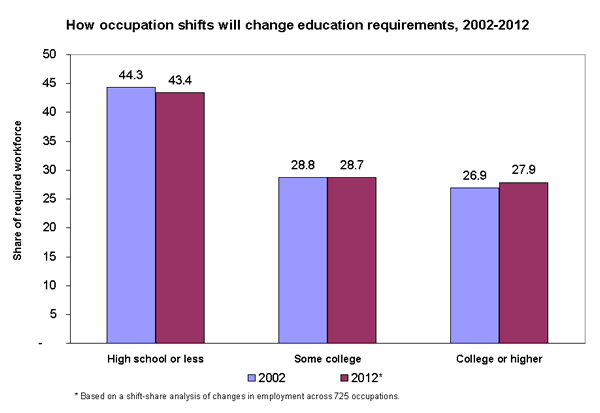See Snapshots Archive.
This Snapshot is a sneak preview of information compiled in the forthcoming EPI book The State of Working America 2004/2005.
Snapshot for July 21, 2004
Jobs in the future: No boom in the need for college graduates
What kind of jobs will exist in the future? Many analysts have conjectured that there will be a bounty of good white-collar jobs and that, as a result, we need not be concerned about the offshoring of white-collar work. However, the Bureau of Labor Statistics (BLS) employment projections, the only data available to analyze this issue, show that there will not be any surge in the need for college-educated workers over the next decade that will offset losses from offshoring (a factor not incorporated in the current BLS projections). Moreover, there is unlikely to be any skills mismatch between the jobs available and the skills of the workforce.
The figure below presents an analysis of how “occupation shifts” (changes in the shares of total employment among 725 occupations) between 2002 and 2012 will affect the demand for workers at three different education levels: those with “high school or less,” those with “some college,” and those with a college degree or more.

The jobs of the future will require only slightly greater education credentials. In 2002, according to the BLS data, the occupational composition of jobs required that 26.9% of the workforce have a college degree or more. This share will rise by one percentage point to 27.9% by 2012. The job shifts will not necessitate the expansion of the share of the workforce with only some college, a group roughly the same size as the college-educated workforce that will be required in 2012. The demand for workers with a high school degree or less will fall slightly, from 44.3% to 43.4% over the 2002 to 2012 period.
A similar analysis (described in the forthcoming EPI publication, State of Working America 2004-2005) shows that employment will be shifting to occupations with higher median annual wages, but the effect will be to raise annual wages by only 1% over 10 years (or 0.1% per year). This is not a large change compared to the real wage growth that occurs each year or to the effects of occupational shifts identified in earlier years.
These projections show that there will continue to be an occupational upgrading in the future whereby the jobs created will be in occupations with somewhat higher wages and educational requirements. This trend has been evident over the last century, and the Bureau of Labor Statistics’ expectations for the future do not appear to be extraordinary in any sense. These projections provide no evidence that employers’ skill demands will outpace the supply of skilled workers expected over the next decade, and there is no evidence of a forthcoming skills gap, a concern often expressed.
Whether workers earn substantially more in the future than they do now, or need greater education levels, will primarily be determined by how much earnings and skills rise within particular occupations rather than by any change we can expect in the occupational composition of jobs. There does not appear to be a strong influx of white-collar jobs on the horizon that will make up for those offshored.
Today’s Snapshot was written by EPI president Lawrence Mishel.
